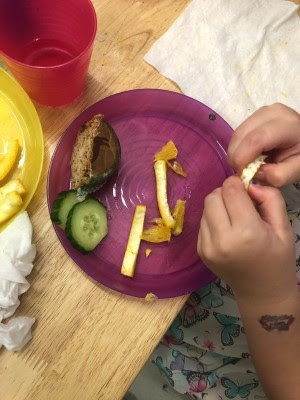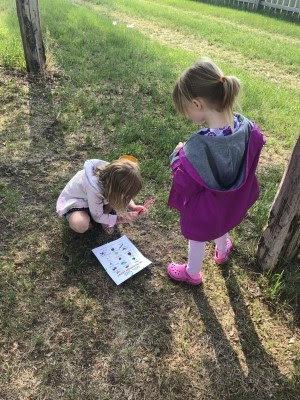These two days were a turning point in my practice for many reasons. For the first time, I had been asked to play for an extended period of time as an adult, without children. Although I had tested out the odd item in my learning environment prior to this conference, I had not really spent time digging in to consider the possibilities that a material may have to offer. I quickly had a new appreciation for the work that children engage in each day as I challenged my own thoughts and beliefs with the natural loose parts that were made available. The realization that I need to play with all materials in my environment for extended periods of time to understand their potential became very apparent. Why had I avoided doing the one thing I hope for children to do each day? Why did taking the time to slow down and play seem like such a new idea? I love to play side by side with children on a daily basis; but just as the children need time to better understand the possibilities that exist without the aid of an adult, I too needed time to find what experiences might live within an array of play experiences without children.

Later on in the day, we were again asked to play, this time with a partner. We were to play in silence with one another while a third party observed and analyzed our play. I was fortunate to play with (at the time) an unfamiliar colleague. Even though we were silent, communication easily flowed between the two of us through out actions and the way we interacted with the intelligent materials. Little did I know, this colleague would become an inspiration within my practices in the years to come. I feel fortunate to have developed a relationship with Michelle Dizy, an early childhood educator from Saskatchewan that practices play based learning with grades prekindergarten through first.

Playing as an adult and making new early learning friends contributed to my growth; but there was a third item that really pushed my practices forward. For the first time, I was introduced to play schema. This was a brand new term for me and I instantly fell in love with this framework. In our institute packages, we were given a handout written by Michelle Thornhill. "Loose Parts and Intelligent Playthings Categorized by Schema" changed the way I observed play and the way I responded to the children that were engaging in the play.
https://brucecounty.on.ca/sites/default/files/Loose%20Parts%20By%20Schema_0.pdf
I used to look at children that were tossing items into the air repeatedly and cringe. A few children building in the block area and crashing down towers, I wanted to scream. This document helped me to see that they were exploring trajectory and breaking through barriers. All of the things that caused me stress during play fell by the wayside. I believed I could now embrace these desires by offering purposeful play experiences that allowed children to explore such phenomenons as enclosing items and transporting them around the environment.

I shared this document with early learning educators that I collaborated with. Each time this document was shared, a high level of excitement and relief was followed. It was as if a light bulb had been turned on and we were no longer in the dark; but rather privy to the secrets that children were exploring. I cherish this article now and refer to it on a regular basis. This is a document that I can no longer teach without and is the first item I share with student teachers, interns and early learning colleagues.

In the winter of 2018, I had the opportunity to visit several prekindergarten classrooms in The Battlefords, Saskatchewan. While in discussion with Angela Yeaman, a prekindergarten teacher and early learning consultant, play schema was brought up. She shared that she had a document from Diane Kashin on play schema in relation to seasons and loose parts. She quickly sent me this document after my visit and it too has become a beloved item. Living in Saskatchewan, the seasons play a large part in the ways in which we live and play on a daily basis which makes this article so fitting within my practice.
https://tecribresearch.wordpress.com/2018/01/28/emergent-curriculum-across-the-seasons-let-nature-be-the-invitation/








